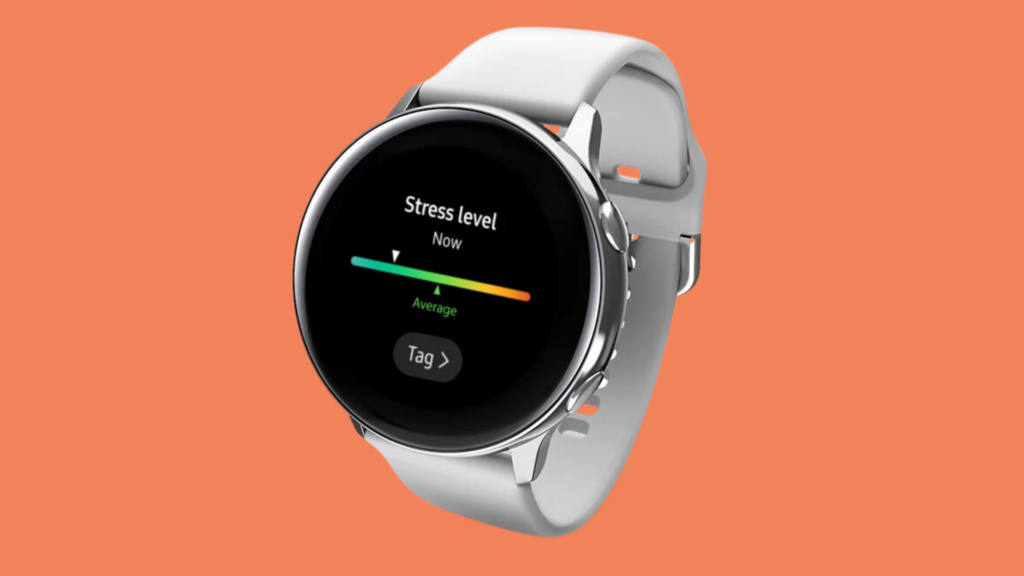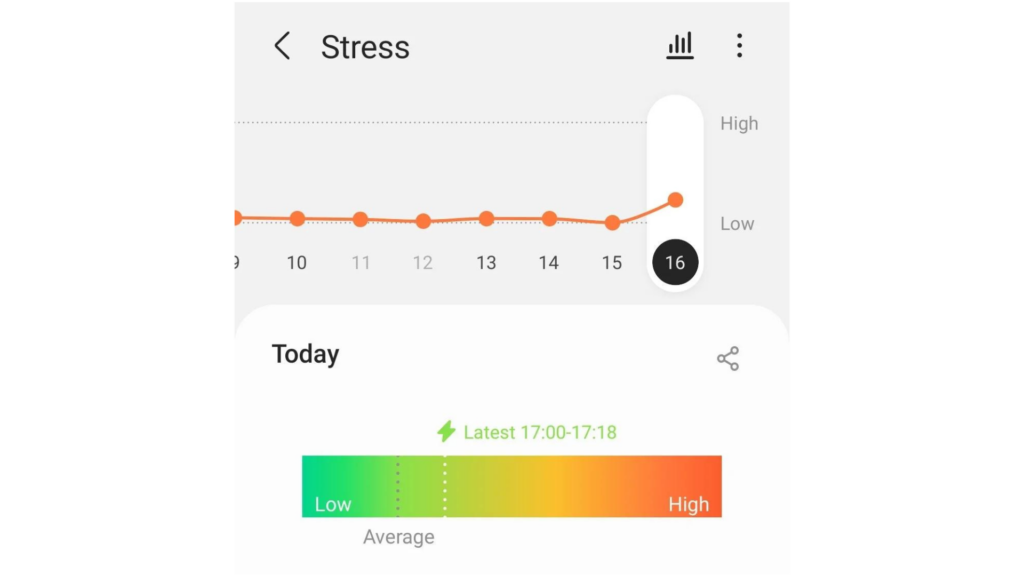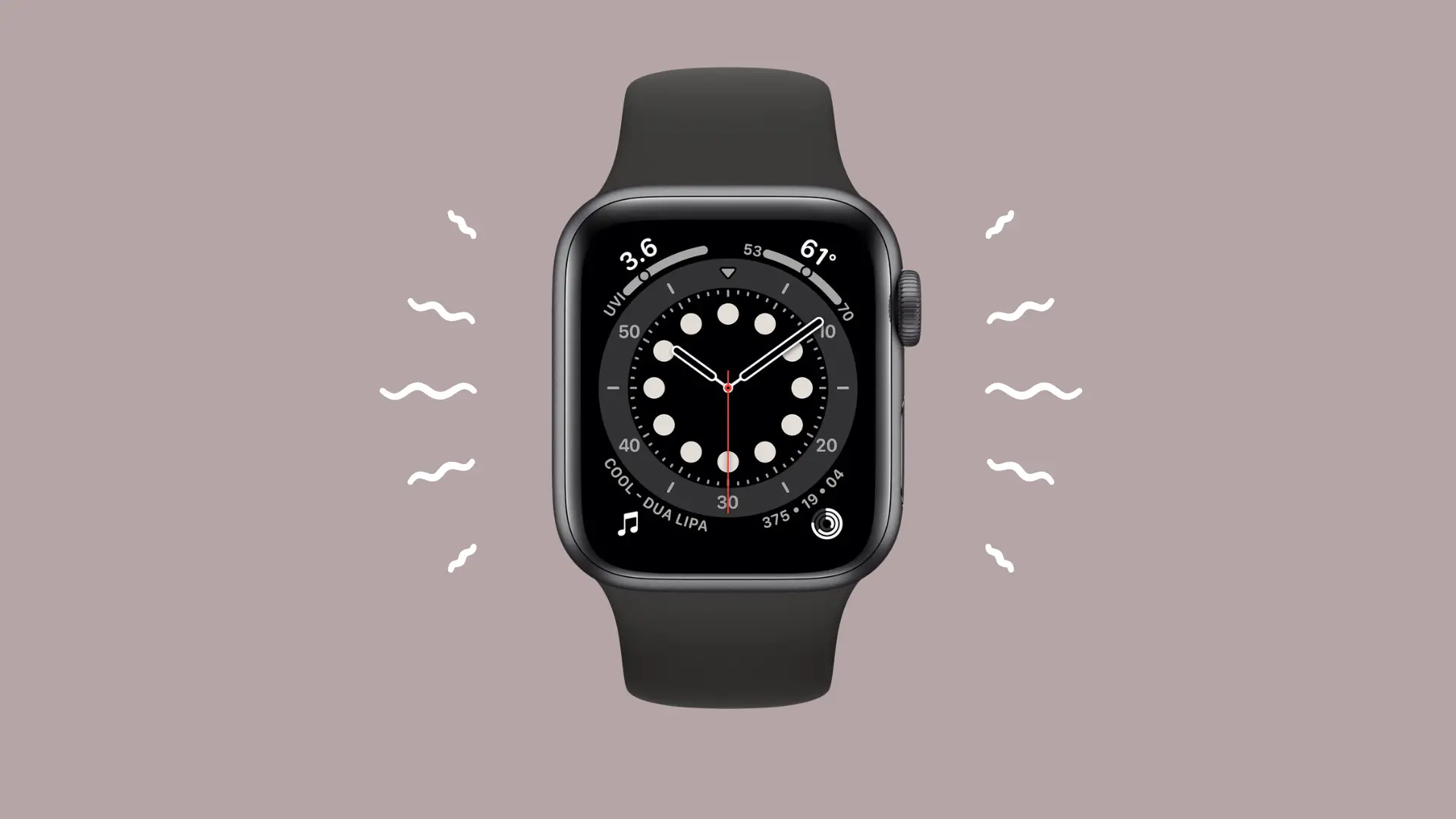How Does Samsung Watch Measure Stress? 4 Ways It Analyzes Your Stress Levels!

Stress is an inevitable part of daily life. But managing it effectively requires awareness of our stress levels. To aid in this, many wearable devices have started providing stress-tracking features.
One such device is the Samsung Watch. This article delves into the fascinating technology behind the Samsung Watch’s stress measurement feature, how it works, its effectiveness, and how it compares to other wearables.
We’ll also share practical tips on how to use this device for stress management. So, if you’ve ever wondered, “How does my Samsung Watch measure stress?” – you’re about to find out.
How Does Samsung Watch Measure Stress? An In-depth Look

The Samsung Watch utilizes a combination of sensors and sophisticated algorithms to detect and measure stress levels in the user. Here’s a closer look at how it works:
Heart Rate Variability (HRV): The fluctuation in the time interval between individual heartbeats. It represents the responsiveness of the heart to various physiological and environmental stimuli. If your HRV goes down, the watch might suggest you’re stressed and recommend taking a break or doing some relaxing activities. If your HRV goes up, that’s a good sign! It could mean that you’re more relaxed or that what you’re doing to manage stress is working well.
Breathing Rate: Stress can also impact our respiration, leading to faster and shallower breaths. The Samsung Watch includes a respiration rate tracker that uses movement and other factors to estimate your breathing rate, which can be an additional indicator of stress.
Activity Level and Sleep Patterns: The Samsung Watch also considers data from physical activity and sleep patterns. The watch can track your movements and sleep through accelerometers and gyroscopes. Sudden changes in these parameters can be a sign of stress, especially if combined with altered HRV and breathing rates.
Samsung’s Stress Measurement Algorithm: Once the Samsung Watch collects these data points, it processes them through Samsung’s proprietary stress measurement algorithm. This algorithm is designed to understand the relationship between these parameters, identify patterns, and estimate your stress level.
In addition to simply providing a stress reading, the Samsung Watch also offers features such as guided breathing exercises to help manage and reduce stress. Remember, the Samsung Watch, like all wearable technology, should be used as part of a comprehensive approach to managing stress and maintaining mental health.
Understanding the Samsung Watch Stress Measurement Algorithm

The Samsung Watch stress measurement algorithm lies at the heart of its stress-detection feature, enabling the device to interpret physiological data and provide a tangible stress score. Here’s a detailed look at how this intricate system functions:
Data Acquisition: Initially, the Samsung Watch acquires crucial data from multiple sensors built into the device. This data primarily includes Heart Rate Variability (HRV), respiration rate, physical activity levels, and sleep patterns.
Data Normalization: As different individuals may have different baseline rates for these parameters (for instance, a professional athlete may have a different average heart rate compared to a non-athlete), the algorithm initially establishes a personalized baseline for each user. This is a critical step in ensuring the accuracy of the stress score.
Pattern Recognition and Analysis: Once the baseline rates are established, the algorithm works to identify deviations from these normal levels. An increase in heart rate, change in respiration rate, reduced sleep quality, or a sudden spike in physical activity can all be indicative of increased stress levels. The algorithm employs advanced pattern recognition techniques to identify these changes.
Stress Score Calculation: Based on the extent and combination of these variations, the algorithm calculates a stress score. This score is presented to the user, providing an estimate of their current stress level. A higher score indicates a higher level of stress.
Ongoing Learning: A unique feature of Samsung’s algorithm is its ability to learn and adapt over time. As it gathers more data about a user’s specific responses to different stressors, it adjusts its understanding of that user’s stress indicators, improving the accuracy of its readings over time.
Keep in mind that while the Samsung Watch’s stress measurement algorithm is complex and sophisticated, it is not designed to replace professional medical advice or diagnosis. It’s a tool designed to provide users with an awareness of their stress levels and guide them in taking proactive steps towards stress management.
Role of Heart Rate Variability (HRV) in Stress Measurement

Heart Rate Variability (HRV) refers to the changes in time intervals between successive heartbeats. It serves as a crucial indicator of physiological responses to stress, enabling the Samsung Watch to provide accurate stress measurements.
A review of several studies found that stress often triggers an overactive SNS and underactive PNS. This imbalance in the ANS can lead to observable changes in HRV, such as a reduction in the high-frequency band (representing PNS activity) and an increase in the low-frequency band (representing SNS activity). This strongly suggests that HRV can serve as a non-invasive gauge of psychological stress.
However, various factors can influence HRV, and thus, stress measurements:
- Individual Differences: People exhibit different HRV responses due to distinct physiological characteristics. As such, the unique HRV of an individual can significantly affect the accuracy of stress measurement.
- Physical Activity: Physical exercise can induce changes in HRV similar to those seen in stress responses. If the Samsung Watch misinterprets these alterations, it could lead to inaccurate stress measurements. Therefore, it’s advisable to take stress readings during rest periods.
- Watch Fit: The proper fitting of the Samsung Watch on the user’s wrist is crucial for accurate HRV readings. A loose or overly tight fit may interfere with the heart rate readings and HRV, leading to potential inaccuracies in the stress measurement.
- Alcohol and Caffeine: Consumption of substances like alcohol and caffeine can affect HRV by altering heart rate and sleep patterns, potentially skewing the stress measurement.
- Medications: Certain medications, particularly those affecting heart rate, blood pressure, or the nervous system, can influence HRV and consequently, stress measurements.
- Time of Day: Natural physiological cycles can lead to fluctuations in HRV throughout the day. Hence, stress measurements may differ significantly depending on the time they are taken.
- Calibration: The Samsung Watch requires a calibration period to establish a baseline for normal HRV and other physiological parameters. The accuracy of stress measurements may be less reliable during this initial calibration period.
Understanding these factors can help users effectively use HRV measurements for stress management. However, the Samsung Watch’s stress measurement feature should serve as a wellness tool and not a substitute for professional medical advice or diagnosis.
The Importance of Breathing Rate in Stress Detection

Breathing rate, or the number of breaths taken per minute, is an often overlooked yet a vital component in detecting stress levels. The human body has a natural response to stress that involves several physiological changes, including alterations in breathing rate. Understanding this link is crucial to comprehending how devices like the Samsung Watch identify and assess stress.
Breathing and the Autonomic Nervous System: The act of breathing is regulated by our autonomic nervous system (ANS), the part of our nervous system that controls bodily functions not consciously directed, such as the beating of the heart. Similar to the heart rate, breathing rate can be influenced by the two branches of the ANS – the sympathetic (our body’s ‘fight or flight’ response) and parasympathetic (our body’s ‘rest and digest’ response) nervous systems.
Stress and Breathing Rate: Under normal conditions, these two systems work together to maintain a steady, regular breathing rate. However, in times of stress, the sympathetic nervous system becomes more dominant, often leading to faster, shallower breaths. Conversely, when we are relaxed and the parasympathetic nervous system is more active, our breaths tend to be slower and deeper.
Breathing Rate as a Stress Indicator: Given this relationship between stress and breathing rate, the latter can serve as an important stress indicator. A significantly increased breathing rate may suggest heightened stress levels, while a slow, steady breathing rate often indicates a relaxed state.
Breathing Rate in Samsung Watch: The Samsung Watch measures breathing rate using a combination of motion sensors and complex algorithms that calculate breaths per minute based on subtle chest movements associated with breathing. By continuously monitoring breathing rates and identifying any significant changes, the Samsung Watch can contribute valuable data to its stress assessment algorithm.
In addition to stress detection, the Samsung Watch also features guided breathing exercises. These exercises aim to help users consciously control their breathing rate, promoting relaxation and stress reduction.
Despite the significance of breathing rate in stress detection, it is essential to remember that stress is a complex phenomenon that cannot be fully assessed by any single physiological measure. Therefore, the Samsung Watch also considers other factors such as heart rate variability, physical activity, and sleep patterns to offer a comprehensive stress evaluation.
Accuracy of Samsung Watch Stress Measurement
When it comes to the accuracy of stress measurements in Samsung smartwatches, there is valuable insight from a study titled “A comprehensive accuracy assessment of Samsung smartwatch heart rate and heart rate variability.” This research provides significant insights into how accurately the Samsung smartwatch measures heart rate variability (HRV), a crucial indicator of stress.
In the study, the researchers evaluated the Samsung Gear Sport smartwatch’s HR and HRV readings against those from a medical-grade chest electrocardiogram (ECG) monitor. The study involved 24-hour monitoring of 28 participants engaged in their regular daily routines, offering a good representation of free-living conditions. The researchers used various statistical methods, including the Pearson correlation coefficient, Bland-Altman plot, and linear regression, to compare the readings from the smartwatch and the ECG monitor.
The findings demonstrated that the smartwatch’s heart rate, time-domain HRV, low-frequency (LF), and high-frequency (HF) parameters were significantly aligned with those of the ECG monitor during sleep time. In other words, the Samsung Gear Sport smartwatch was found to provide relatively accurate readings for these parameters during sleep.
However, the results were different during the participants’ awake periods. During these times, the smartwatch only showed satisfactory accuracy for the average time between beats (AVNN) and heart rate, while other HRV parameters exhibited high error rates.
Despite these limitations, the Samsung smartwatch’s stress measurement feature still offers valuable insights for users looking to manage their stress levels since HRV is only one of Samsung’s measurements for assessing stress. Additionally, there are a few things you can do to increase the accuracy of the device.
Factors Affecting the Accuracy of Stress Measurement
The stress measurement feature of the Samsung Watch offers a valuable method to gauge our stress levels. However, it’s crucial to be aware that several variables can potentially affect its accuracy. Here are a few important factors to keep in mind:
- Personal Physiological Responses: Each individual’s body reacts uniquely to stress. For some, stress might cause a significant increase in heart rate, while for others, the changes might be less noticeable. Such differences can substantially influence the accuracy of the stress measurement.
- Physical Activity: Physical exercise can lead to alterations in heart and breathing rates similar to stress responses. If the watch incorrectly interprets these changes, it could result in imprecise stress readings. To avoid this, stress measurements should ideally be taken during moments of rest.
- Appropriate Fit: The Samsung Watch needs to be correctly fitted on the user’s wrist for accurate stress measurement. If the watch is too tight or too loose, it might fail to accurately monitor heart rate or identify breathing patterns, causing potential inaccuracies in the stress score.
- Consumption of Alcohol and Caffeine: Both alcohol and caffeine can have an impact on heart rate and sleep habits, which could lead to inaccurate stress measurements.
- Medication: Certain drugs, particularly those influencing heart rate, blood pressure, or the nervous system, can affect the readings from the Samsung Watch and may result in incorrect stress scores.
- Time of Day: Our bodies naturally undergo cycles of stress and relaxation throughout the day. Consequently, readings taken at different times may vary considerably and may not necessarily depict changes in stress levels accurately.
- Need for Calibration: The Samsung Watch requires time to establish a baseline for your typical heart rate variability, breathing rate, and other physiological parameters. The reliability of stress measurements might be less accurate during this initial calibration period.
Bear in mind, the stress measurement feature of the Samsung Watch is intended as a wellness tool and should not replace professional medical consultations or diagnoses. It’s a useful tool to understand your body’s reactions and manage your stress levels, but it should be utilized alongside other health practices for optimal results.
How to Calibrate Your Samsung Watch for Stress Measurement
Proper calibration is a crucial step in using your Samsung Watch effectively for stress measurement. The device needs to establish baseline measurements to accurately assess changes indicative of stress. Here’s how to ensure your Samsung Watch is correctly calibrated for this purpose:
To help you with the process, here are the detailed steps on how to recalibrate your Galaxy Watch:
- Access the History: Begin at the Home screen of your Galaxy Watch. Navigate to the bottom and press the “View history” option.
- Open the More Menu: Look for the More menu located at the top right corner of the screen and tap it.
- Choose Recalibration: In the menu that appears, you should see an option labeled “Recalibrate.” Select this to start the recalibration process.
- Complete Recalibration: Finally, tap on “Recalibrate the watch.” Once done, you can return to the Home screen.
Other steps to help improve the accuracy of your Samsung Watch:
1. Wear the Watch Correctly: Ensure that the watch fits snugly on your wrist. It should not be too tight, causing discomfort, or too loose, allowing the watch to move around. The heart rate sensor at the back of the watch should maintain consistent contact with your skin.
2. Initial Set Up: When you first use your Samsung Watch, it will guide you through a setup process. This process will request necessary health information such as your age, height, weight, and gender. Be sure to input accurate information, as this will affect the initial calibration of your device.
3. Establish Baseline Measurements: The watch requires some time to understand your average heart rate, HRV (Heart Rate Variability), and breathing rate under normal, non-stressful conditions. This process typically requires wearing the watch consistently for a few days to a week. During this period, try to go about your normal routine and ensure that the watch is worn during different activities and stress levels.
4. Regularly Sync Your Watch: Sync your Samsung Watch with the Samsung Health app on your smartphone regularly. This allows the watch to process and analyze the collected data more efficiently, improving its calibration over time.
5. Manual Stress Measurement: Regularly use the manual ‘Measure stress’ feature in the Samsung Health app on your watch. This provides the watch with additional data points to enhance its calibration process.
6. Regular Software Updates: Make sure to keep your Samsung Watch software updated. Updates often include improvements to measurement algorithms, ensuring your watch’s stress measurements remain accurate.
Remember, the stress measurement feature of the Samsung Watch is designed to be a wellness tool. While it can give you insight into your stress levels and help guide stress management techniques, it is not a substitute for professional medical advice. Always consult a healthcare professional if you’re experiencing high levels of stress or if you have any concerns about your mental health.
Using Samsung Watch for Stress Management: Practical Tips

The Samsung Watch offers a variety of features that can be useful for managing stress. Here are some practical tips on how to make the most out of these tools:
1. Regularly Check Your Stress Levels: Make it a habit to regularly check your stress levels on your Samsung Watch. Understanding your stress patterns throughout the day can help you identify potential stressors and implement effective coping strategies.
2. Utilize Guided Breathing Exercises: The Samsung Watch provides guided breathing exercises that you can use during high-stress moments. These exercises can help calm your mind and body, potentially reducing your stress levels.
3. Monitor Trends Over Time: Use the Samsung Health app to track your stress levels over time. Understanding your long-term stress patterns can give you insights into when you are most stressed and help you manage your stress more effectively.
4. Ensure Proper Calibration: Ensure that your Samsung Watch is properly calibrated by wearing it consistently, entering accurate health information, and regularly syncing it with the Samsung Health app.
5. Practice Good Sleep Hygiene: Stress and sleep are closely linked. The Samsung Watch can track your sleep patterns, which can provide valuable insights into your overall stress management. Aim for a consistent sleep schedule and good sleep hygiene for better stress management.
6. Incorporate Physical Activity: Regular physical activity can be an effective way to manage stress. Use your Samsung Watch to set and track fitness goals and to motivate you to move more throughout the day.
7. Balance Alerts and Downtime: While it’s important to stay connected, constant alerts can contribute to stress. Make use of the ‘Do Not Disturb’ and ‘Goodnight’ modes on your Samsung Watch to balance connectivity and downtime.
Remember, while the Samsung Watch can be a useful tool in managing stress, it’s not a replacement for professional help. If you’re struggling with chronic high stress, consider reaching out to a healthcare professional or a mental health expert. They can provide you with more personalized strategies and resources for managing stress effectively.





